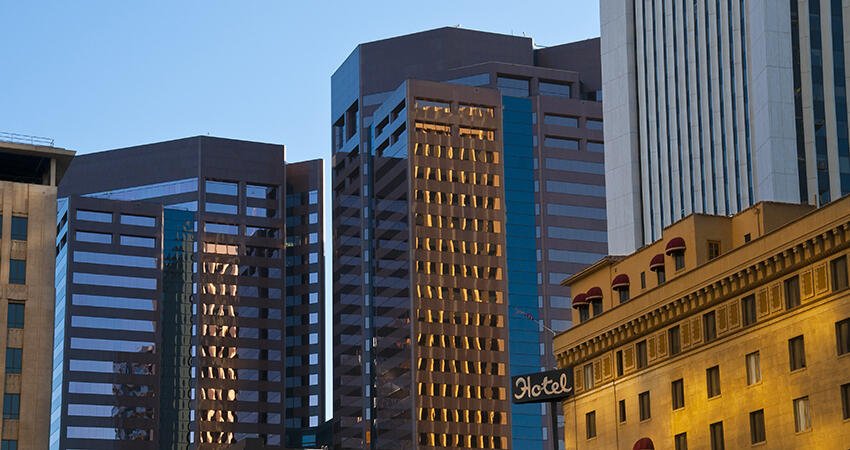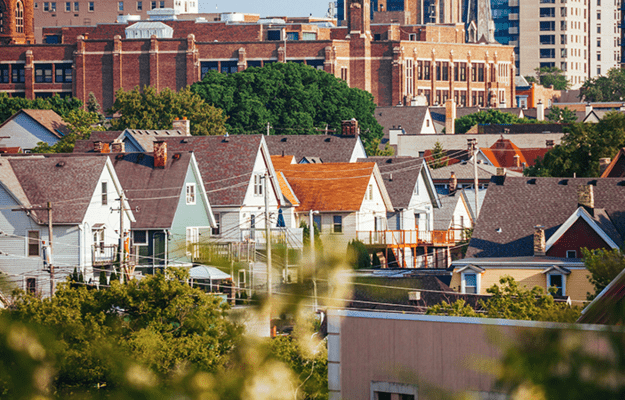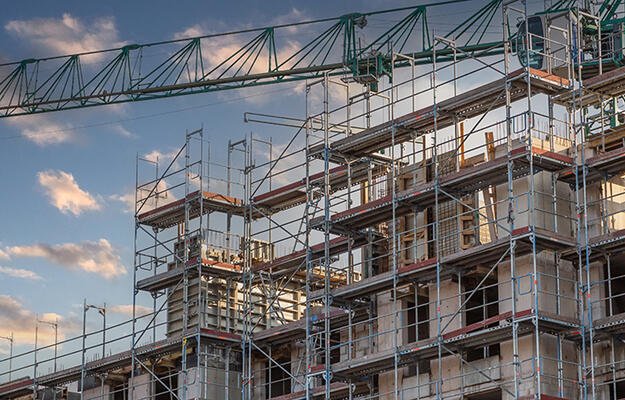
(JacobH/Getty Images)
To Save Downtowns, Cities Need to Do More Than Turn Offices into Housing
This post was originally published on Urban Wire, the blog of the Urban Institute.
Downtowns in the United States continue to struggle with the effects of the COVID-19 pandemic. The unprecedented shift to working from home, declines in mass transit ridership, and fear of crime have made it difficult for many city centers to recover. At the same time, the nation faces a growing housing shortage.
To both reduce vacant office space and address the lack of affordable housing, some cities—as well as the White House—have proposed turning obsolete office buildings into housing. Though residential conversions can be a part of revitalizing downtowns, they are often costly and insufficient to address the challenges facing our cities. To save downtowns, we need to reimagine office districts into vibrant, resilient, mixed-use areas that are not just for workers, but a variety of residents and visitors.
Though they increase housing supply, residential conversions are challenging and costly
Converting office buildings to housing is not simple. The physical layout of office buildings often makes it difficult and costly to convert them into residential units. Zoning and land-use laws often restrict residential conversions or require builders to obtain time-consuming waivers. Logistical challenges, such as long-term leases signed by existing tenants, can make it challenging to completely empty office buildings. Turning offices into affordable, family-friendly housing is even more difficult, as it would likely require significant subsidies. Finally, to attract new residents, these areas will require a new range of services and amenities, including neighborhood retail and grocery stores.
These limitations mean residential conversions are likely to be relatively limited and ultimately insufficient for most localities to revitalize struggling downtowns or significantly address broader housing needs.
Strategies to revitalize downtowns
As project manager of Washington, DC’s Downtown Action Plan, I’ve had a front-row seat to the problems currently facing downtowns. More than three years after the pandemic, DC’s downtown has one of the lowest recovery rates. This is largely because federal employees—who represent about one-third of workers in downtown DC—have not returned to offices at the same rate as private-sector workers.
Despite this worrisome context, policymakers, residents, and downtown businesses have told me they’re excited to reimagine a downtown that reflects the best of DC—ample parks and public spaces, pedestrian-friendly roads, a lively restaurant scene, a unique neighborhood character, and housing with amenities like grocery stores and pharmacies close by.
While converting offices into housing can help with revitalization efforts, cities will need to do more to save their downtowns. In addition to residential conversions, cities will need to employ various strategies to turn their office districts into vibrant, resilient, mixed-use areas.
Here are three ways cities could reimagine their downtowns:
- Strengthen and grow arts, culture, and entertainment areas. Downtowns are often a region’s geographic and commercial center, supported by legacy infrastructure built to transport people in and out. As such, they are convenient locations for sports, entertainment, and cultural events. Cities with struggling downtowns could explore growing these markets. City parks, public spaces, and closed roads for special events can attract regional and national visitors while supporting small and local businesses. Cultural districts can take many forms: some are anchored by cultural institutions, like museums and theaters, and others offer spaces for cultural production, such as artist studios and broadcast facilities. In recent decades, cities have successfully built mixed-use sports districts where people can live, work, and watch their favorite teams play.
- Establish education or innovation hubs. University campuses can help cities revitalize downtown areas. Arizona State University created a campus in downtown Phoenix, Arizona, that included converting an office building into an administrative and student-services center. In 2019, the downtown campus directly employed nearly 3,400 people, according to the university’s calculations. Though the innovation district model often centers around a single university, cities could support more than one campus. In downtown Washington, DC, there is a growing market for national and international universities to create campuses. If planned well, cities can foster diverse, vibrant university districts in the heart of legacy downtowns.
- Develop convening districts. As the demand for traditional office space continues to decline, some policymakers may try to fill vacant offices by offering incentives for major employers to relocate to their cities. As hybrid work continues to grow, however, these relocations might be on a much smaller scale and bring fewer new jobs. Still, some employers have recognized the value of bringing their employees together in person. In DC, there’s demand for additional meeting spaces, as local, national, and global employers seek to convene their staff on a regular basis or for one-off events, such as conferences. As the workplace continues to evolve, policymakers should pay close attention to what major employers need and be prepared to adjust their regulations, incentives, and approaches to meet that need.


